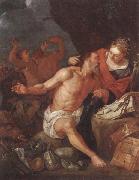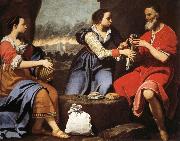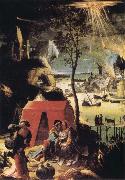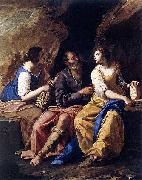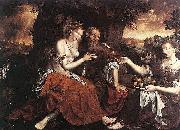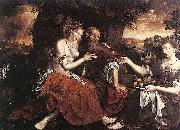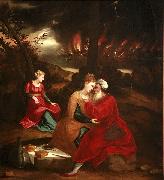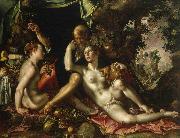Wholesale Oil Painting No Minimum |
|||||||||||
|
|
|||||||||||

|
|||||||||||
|
|
|
||||||||
Jacob ToorenvlietDutch Baroque Era Painter , Leiden circa 1635-1719 |
||||||||
|
|
||||||||
Lot and his daughters
Lot and his daughters Painting ID:: 27356 |
mk56
oil on canvas
mk56 oil on canvas |
|||||||
|
|
||||||||
Lorenzo Lippi1606-65 Italian painter and poet. He was trained by Matteo Rosselli, with whom he worked for many years in close partnership. His collaboration was sometimes anonymous but is documented from 1622, when they decorated the ceiling of the Sala della Stufa (Florence, Pitti), to 1631-2, when they worked together on lunettes portraying St Francis Adoring the Child and St Catherine in Prison (Florence, S Gaetano). In 1630 Lippi was enrolled in the Accademia del Disegno but appears not to have had his own workshop until after 1634, although he worked independently before then. The earliest paintings attributable to him are, both in facial types and in the soft, rich folds of the drapery, close in style to the work of Rosselli. Examples include canvases of the Apostles James, John and Matthew, and Christ Blessing (all 1628; Vaglia, S Pietro), and the Virgin Handing the Child to St Francis (1629; Florence, S Salvatore di Camaldoli). In the 1630s Lippi painted decorative and theatrical compositions, mainly on literary and biblical themes, which remained indebted to Rosselli, for example Samson and Delilah (1632; Stockholm, Nmus.) and the Virgin in Glory with Saints (1634; Ronta, nr Barberino di Mugello, S Michele). Shortly afterwards he produced works |
||||||||
|
|
||||||||
|
|
Lot and His Daughters
Lot and His Daughters Painting ID:: 29962 |
mk67
Oil on canvas
58 1/4x72 13/16in
Uffizi mk67 Oil on canvas 58 1/4x72 13/16in Uffizi |
||||||
|
|
||||||||
Lucas van Leyden1489-1533 Dutch Lucas van Leyden Galleries Lucas van Leyden (Leiden, 1494 ?C August 8, 1533 in Leiden), also named either Lucas Hugensz or Lucas Jacobsz, was a Dutch engraver and painter, born and mainly active in Leiden, who was among the first Dutch exponents of genre painting and is generally regarded as one of the finest engravers in the history of art. He was the pupil of his father, from whose hand no works are known, and of Cornelis Engelbrechtsz, but both of these were painters whereas Lucas himself was principally an engraver. Where he learnt engraving is unknown, but he was highly skilled in that art at a very early age: the earliest known print by him (Mohammed and the Murdered Monk) dates from 1508, when he was perhaps only 14, yet reveals no trace of immaturity in inspiration or technique. Lot and his daughters (ca. 1509)In 1514 he entered the Painters' Guild at Leiden. He seems to have travelled a certain amount, and visits are recorded to Antwerp in 1521, the year of D??rer's Netherlandish journey, and to Middelburg in 1527, when he met Jan Mabuse. An unbroken series of dated engravings makes it possible to follow his career as a print-maker and to date many of his paintings, but no clear pattern of stylistic development emerges. D??rer was the single greatest influence on him, but Lucas was less intellectual in his approach, tending to concentrate on the anecdotal features of the subject and to take delight in caricatures and genre motifs. Carel van Mander characterizes Lucas as a pleasure-loving dilettante, who sometimes worked in bed, but he left a large oeuvre, in spite of his fairly early death, and must have been a prodigious worker. Lucas had a great reputation in his day (Vasari even rated him above D??rer) and is universally regarded as one of the greatest figures in the history of graphic art (he made etchings and woodcuts as well as engravings and was a prolific draughtsman). His status as a painter is less elevated, but he was undoubtedly one of the outstanding Netherlandish painters of his period. He was a pioneer of the Netherlandish genre tradition, as witness his Chess Players (Gemäldegalerie, Berlin) which actually represents a variant game called 'courier' - and his Card Players (National Gallery of Art, Washington), while his celebrated Last Judgement triptych (Lakenhal Museum, Leiden, 1526-27) shows the heights to which he could rise as a religious painter. It eloquently displays his vivid imaginative powers, his marvellous skill as a colourist and his deft and fluid brushwork. |
||||||||
|
|
||||||||
|
|
Lot and his Daughters
Lot and his Daughters Painting ID:: 33537 |
mk86
v.1520
Oil on wood
48x34cm
Paris,Musee National du Louvre
mk86 v.1520 Oil on wood 48x34cm Paris,Musee National du Louvre |
||||||
|
|
||||||||
Gustave Courbet1819-1877 French Gustave Courbet Locations was a French painter whose powerful pictures of peasants and scenes of everyday life established him as the leading figure of the realist movement of the mid-19th century. Gustave Courbet was born at Ornans on June 10, 1819. He appears to have inherited his vigorous temperament from his father, a landowner and prominent personality in the Franche-Comte region. At the age of 18 Gustave went to the College Royal at Besancon. There he openly expressed his dissatisfaction with the traditional classical subjects he was obliged to study, going so far as to lead a revolt among the students. In 1838 he was enrolled as an externe and could simultaneously attend the classes of Charles Flajoulot, director of the ecole des Beaux-Arts. At the college in Besançon, Courbet became fast friends with Max Buchon, whose Essais Poetiques (1839) he illustrated with four lithographs. In 1840 Courbet went to Paris to study law, but he decided to become a painter and spent much time copying in the Louvre. In 1844 his Self-Portrait with Black Dog was exhibited at the Salon. The following year he submitted five pictures; only one, Le Guitarrero, was accepted. After a complete rejection in 1847, the Liberal Jury of 1848 accepted all 10 of his entries, and the critic Champfleury, who was to become Courbet first staunch apologist, highly praised the Walpurgis Night. |
||||||||
|
|
||||||||
|
|
Lot and his Daughters
Lot and his Daughters Painting ID:: 55221 |
mk240
1844
Oil on canvas
89x116cm
mk240 1844 Oil on canvas 89x116cm |
||||||
|
|
||||||||
Artemisia gentileschi1593-1652 was an Italian Early Baroque painter, today considered one of the most accomplished painters in the generation influenced by Caravaggio. In an era when women painters were not easily accepted by the artistic community, she was the first female painter to become a member of the Accademia di Arte del Disegno in Florence. She was one of the first female artists to paint historical and religious paintings, at a time when such heroic themes were considered beyond a woman's reach. Artemisia Gentileschi was born in Rome, July 8, 1593, the first child of the Tuscan painter Orazio Gentileschi, one of the best representatives of the school of Caravaggio. Artemisia was introduced to painting in her father's workshop, showing much more talent than her brothers, who worked alongside her. She learned drawing, how to mix color and how to paint. Since her father's style took inspiration from Caravaggio during that period, her style was just as heavily influenced in turn. But her approach to subject matter was different from her father's, as her paintings are highly naturalistic, where Orazio's are idealized. The first work of the young 17-year-old Artemisia (even if many at the time suspected that she was helped by her father) was the Susanna e i Vecchioni (Susanna and the Elders) (1610, Schönborn collection in Pommersfelden). The picture shows how Artemisia assimilated the realism of Caravaggio without being indifferent to the language of the Bologna school (which had Annibale Carracci among its major artists). It is one of the few Susanna paintings showing the two men planning their sexual harassment. It is likely that Artemisia had been sexually harrassed and painted Susanna as a reflection. In 1612, despite her early talent, Artemisia was denied access to the all-male professional academies for art. At the time, her father was working with Agostino Tassi to decorate the vaults of Casino della Rose inside the Pallavicini Rospigliosi Palace in Rome, so Orazio hired the painter to tutor his daughter privately. During this tutelage, Tassi raped Artemisia. Another man, Cosimo Quorlis had helped Tassi with the rape. After the initial rape, Artemisia continued to have sexual relations with Tassi, with the expectation that they were going to be married. However, Tassi reneged on his promise to marry Artemisia after he heard the rumor that she was having an affair with another man. Quorlis had threatened that if he could not have her, he would publicly humiliate her. Orazio pressed charges against Tassi only after he learned that Artemisia and Tassi were not going to be married. Orazio also claimed that Tassi stole a painting of Judith from the Gentileschi household. The major issue of this trial was the fact that Tassi had deflowered Artemisia. If Artemisia had not been a virgin before Tassi raped her, the Gentileschis would not be able to press charges. In the ensuing 7-month trial, it was discovered that Tassi had planned to murder his wife, had enjoined in adultery with his sister-in-law and planned to steal some of Orazio??s paintings. During the trial Artemisia was given a gynecological examination and was tortured using a device made of thongs wrapped around the fingers and tightened by degrees ?? a particularly cruel torture to a painter. Both procedures were used to corroborate the truth of her allegation, the torture device used due to the belief that if a person can tell the same story under torture as without it, the story must be true. At the end of the trial Tassi was imprisoned for one year. The trial has subsequently influenced the feminist view of Artemisia Gentileschi during the late 20th century. The painting Giuditta che decapita Oloferne (Judith beheading Holofernes) (1612 - 1613), displayed in the Capodimonte Museum of Naples, is impressive for the violence portrayed, and has been interpreted as a wish for psychological revenge for the violence Artemisia had suffered. One month after the trial, in order to restore her honor, Orazio arranged for his daughter to marry Pierantonio Stiattesi, a modest artist from Florence. Shortly afterwards the couple moved to Florence, where Artemisia received a commission for a painting at Casa Buonarroti and became a successful court painter, enjoying the patronage of the Medici family and Charles I. It has been proposed that during this period Artemisia also painted the Madonna col Bambino (The Virgin and Child), currently in the Spada Gallery, Rome. While in Florence, |
||||||||
|
|
||||||||
|
|
Lot and his Daughters
Lot and his Daughters Painting ID:: 71434 |
Date 1635-1638
Medium Oil on canvas
Dimensions 230.5 x 183 cm
Date 1635-1638 Medium Oil on canvas Dimensions 230.5 x 183 cm |
||||||
|
|
||||||||
Jan Massijspainted David and Bathsheba in 1562 |
||||||||
|
|
||||||||
|
|
Lot and His Daughters
Lot and His Daughters Painting ID:: 82506 |
1565
Oil on oak, 148 x 204,5 cm
cjr 1565 Oil on oak, 148 x 204,5 cm cjr |
||||||
|
|
||||||||
Jan Massijspainted David and Bathsheba in 1562 |
||||||||
|
|
||||||||
|
|
Lot and His Daughters
Lot and His Daughters Painting ID:: 85961 |
1565(1565)
Medium Oil on oak
cyf 1565(1565) Medium Oil on oak cyf |
||||||
|
|
||||||||
Bonifacio de Pitatipainted Sacra Conversazione in 1515 |
||||||||
|
|
||||||||
|
|
Lot and his daughters
Lot and his daughters Painting ID:: 90766 |
Early-mid 16th century
Medium oil on canvas
cjr Early-mid 16th century Medium oil on canvas cjr |
||||||
|
|
||||||||
Joachim Wtewael1566-1638 Flemish Joachim Wtewael Galleries Dutch painter and draughtsman. He was one of the last exponents of MANNERISM. From c. 1590 until 1628, the year of his latest known dated paintings, he employed such typical Mannerist formal devices as brilliant decorative colour, contrived spatial design and contorted poses. He sometimes combined such artifice with naturalism, and this amalgam represents the two approaches Dutch 16th- and 17th-century theorists discussed as uyt den geest (from the imagination) and naer t leven (after life). Wtewaels activity reflects the transition from Mannerism to a more naturalistic style in Dutch art. Slightly over 100 of his paintings and about 80 drawings are known. Subjects from the Bible and mythology predominate; he also painted several portraits, including a Self-portrait (1601; Utrecht, Cent. Mus.). |
||||||||
|
|
||||||||
|
|
Lot and his Daughters
Lot and his Daughters Painting ID:: 95443 |
circa 1600(1600)
Medium oil on canvas
cyf circa 1600(1600) Medium oil on canvas cyf |
||||||
|
|
||||||||
|
Joachim Wtewael 1566-1638 Flemish Joachim Wtewael Galleries Dutch painter and draughtsman. He was one of the last exponents of MANNERISM. From c. 1590 until 1628, the year of his latest known dated paintings, he employed such typical Mannerist formal devices as brilliant decorative colour, contrived spatial design and contorted poses. He sometimes combined such artifice with naturalism, and this amalgam represents the two approaches Dutch 16th- and 17th-century theorists discussed as uyt den geest (from the imagination) and naer t leven (after life). Wtewaels activity reflects the transition from Mannerism to a more naturalistic style in Dutch art. Slightly over 100 of his paintings and about 80 drawings are known. Subjects from the Bible and mythology predominate; he also painted several portraits, including a Self-portrait (1601; Utrecht, Cent. Mus.). Lot and his Daughters circa 1600(1600) Medium oil on canvas cyf |
||||||||
|
|
||||||||
|
Prev Next
|
||||||||
|
|
||||||||
|
Related Paintings to Joachim Wtewael :. |
||||||||
|
|
||||||||
|
CONTACT US |
